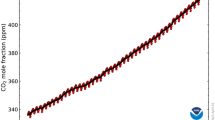Abstract
Spoils samples collected from a coal strip mine in southeastern Montana were examined for populations and activities of iron- and sulfur-oxidizing bacteria. Spoils examined were of three types: (a) acidic pyrite-rich waste coal, (b) oxidation halo material, and (c) alkaline material, which was the most widespread type. Bacterial numbers, sulfur oxidation, and14CO2 uptake activity declined to low levels in the summer when spoils were dry. Even in wetter spring months pyritic spoils contained relatively low numbers of acidophilic iron- and sulfur-oxidizing bacteria, probably indicative of water stress since the same spoils incubated with excess water or dilute mineral salts showed considerably greater bacterial numbers and activity. Certain wells in coal and spoils aquifers contained substantial populations of iron-oxidizing acidophilic bacteria. However, these wells were always of alkaline or neutral pH, indicating that bacterial pyrite oxidation occurred where groundwaters contacted either replaced spoils or coal that contained pyrite or other metal sulfides. Bacterial activity may contribute to trace metal and sulfate leaching in the area.
Similar content being viewed by others
References
Bardsley, C. A., and J. D. Lancaster: Sulfur. In C. A. Black (ed.): Methods of Soil Analysis, Part 2, Chemical and Microbiological Properties, pp. 1111–1113. American Society of Agronomy, Madison, Wis. (1965)
Belly, R. T., and T. D. Brock: Ecology of iron-oxidizing bacteria in pyritic materials associated with coal. J. Bacteriol.117, 726–732 (1974)
Brock, T. D.: Effect of water potential on growth and iron oxidation byThiobacillus ferrooxidans. Appl. Microbiol.29, 495–501 (1975)
Chadwick, R. A., R. A. Woodriff, R. W. Stone, and C. M. Bennett: Lateral and vertical variations in sulfur and trace elements in coal: Colstrip field, Montana. In W. F. Clark (ed.): Proceedings of the Fort Union Coal Field Symposium, pp. 362–370. Eastern Montana College, Billings, Montana (1975)
Chadwick, R. A., R. C. Rice, C. M. Bennett, and R. A. Woodriff: Sulfur and trace elements in the Rosebud and McKay Coal Seams, Colstrip Coal Field, Montana. In: Energy Resources of Montana, Montana Geol. Soc., 22nd Annual Publication (1975)
Cundell, A. M.: The role of microorganisms in the revegetation of stripmined land in the western United States. J. Range Management30, 299–305 (1977)
Dockins, W. S., G. J. Olson, G. A. McFeters, and S. C. Turbak: Dissimilatory bacterial sulfate reduction in Montana groundwaters. Geomicrobiol. J.2, 83–98 (1980)
Dollhopf, D. J., J. D. Goering, C. J. Levine, B. J. Bauman, D. W. Hedberg, and R. L. Hodder: Selective placement of coal stripmine overburden in Montana. III. Spoil mixing phenomena. Montana Agricultural Experiment Station Interim Report. Montana State University, Bozeman (1978)
Fliermans, C. B.and T. D. Brock: Assay of elemental sulfur in soil. Soil Sci.115, 120–122 (1973)
Griffith, E. D., and A. W. Clarke: World coal production. Sci. Am.240, 38–47 (1979)
Hach Chemical Company: Hach Water Analysis Handbook. Hach Chemical Company, Ames, Iowa (1973)
Harris, R. F., W. R. Gardner, A. A. Adebayo, and L. E. Sommers: Agar dish isopiestic equilibration method for controlling the water potential of solid substrates. Appl. Microbiol.19, 536–537 (1970)
Harrison, A. P.: Microbial succession and mineral leaching in an artificial coal spoil. Appl. Environ. Microbiol.36, 861–869 (1978)
Hutchinson, M., K. I. Johnstone, and D. White: The taxonomy of certain thiobacilli. J. Gen. Microbiol.41, 357–366 (1965)
Hutchinson, M., K. I. Johnstone, and D. White: Taxonomy of the acidophilic thiobacilli. J. Gen. Microbiol.44, 373–381 (1966)
Hutchinson, M., K. I. Johnstone, and D. White: Taxonomy of the anaerobic thiobacilli. J. Gen. Microbiol.47, 17–27 (1967)
Hutchinson, M., K. I. Johnstone, and D. A. White: Taxonomy of the genusThiobacillus: the outcome of numerical taxonomy applied to the group as a whole. J. Gen. Microbiol.57, 397–410 (1969)
Kleinmann, R. L. P., and D. A. Crerar:Thiobacillus ferrooxidans and the formation of acidity in simulated coal mine environments. Geomicrobiol. J.1, 373–388 (1979)
Moser, U. S., and R. V. Olson: Sulfur oxidation in four soils as influenced by soil moisture tension and sulfur bacteria. Soil Sci.76, 251–257 (1953)
Nor, Y. M., and M. A. Tabatabai: Extraction and colorimetric determination of thiosulfate and tetrathionate in soils. Soil Sci.122, 171–178 (1976)
Olson, G. J., S. C. Turbak, and G. A. McFeters: Impact of western coal mining. II. Microbiological studies. Water Res.13, 1033–1041 (1979)
Postgate, J. R.: Versatile medium for the enumeration of sulfate-reducing bacteria. Appl. Microbiol.11, 265–267 (1963)
Shivvers, D. W., and T. D. Brock: Oxidation of elemental sulfur bySulfolobus acidocaldarius. J. Bacteriol.114, 706–710 (1973)
Silverman, M. P., and D. G. Lundgren: Studies on the chemoautotrophic iron bacteriumFerrobacillus ferrooxidans. I. An improved medium and a harvesting procedure for securing high cell yields. J. Bacteriol.77, 642–647 (1959)
Strickland, J. D. H., and T. R. Parsons: A Practical Handbook of Seawater Analysis, 2nd Ed., Bull. 167. Fisheries Research Board of Canada, Ottawa, Ontario (1972)
Swaby, R. J., and R. Fedel: Effect of climate on oxidation and reduction of sulfur compounds in soils. In M. W. Loutit and J. A. R. Miles (eds.): Microbial Ecology. Springer-Verlag, New York (1978)
Whitworth, C., and G. K. Pagenkopf: Cadmium complexation by coal humic acid. J. Inorg. Nucl. Chem.41, 317–321 (1979)
Author information
Authors and Affiliations
Rights and permissions
About this article
Cite this article
Olson, G.J., McFeters, G.A. & Temple, K.L. Occurrence and activity of iron- and sulfur-oxidizing microorganisms in alkaline coal strip mine spoils. Microb Ecol 7, 39–50 (1981). https://doi.org/10.1007/BF02010477
Issue Date:
DOI: https://doi.org/10.1007/BF02010477




